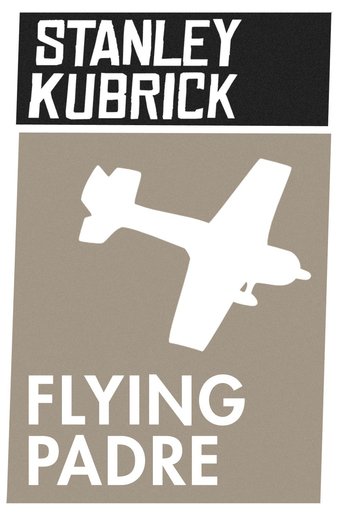ackstasis
In an attempt to experience absolutely everything that Stanley Kubrick has to offer, I have set my sights towards his three early documentary shorts (though, admittedly, I also still have a couple of feature films to go). 'Flying Padre' seemed as good a place as any to start. I'd say that I was slightly disappointed with the film, but I really couldn't have expected much better from the director's first effort. This being his first project, Kubrick would most likely have lacked any creative control, and he would have been expected to simply do things by the book. Just four years later, given complete artistic control (and a shoestring budget), the mastery of this master director would begin to shine through with 'Killer's Kiss.''Flying Padre' is a cheery nine-minute documentary detailing the kind-hearted exploits of a priest in an isolated country region. Equipped with his $2000, single-motor plane, The Spirit of St. Joseph, this "flying padre" is able to spread his compassion and goodwill across a 1200 mile expanse, never asking anything in return for his unwavering commitment to society. The film follows the priest across two "ordinary days," as he attends to such diverse errands as a country funeral, a child bully, a sick baby and looking after his flock of breeding canaries.If it hadn't been for a tiny director credit at the beginning of the film, I would never have guessed that Kubrick was involved in any way. The acting is quite poor and, despite the narrator's assurances that all these adventures are happening spontaneously, it's obvious that most of the shots have been pre-planned. How, otherwise, can they explain that the cameraman reached the house of the sick baby long before the padre ever did?! On a side note, however, I did enjoy the very final shot of the film, as the ambulance carrying the sick baby accelerates away from the priest standing beside his plane. From the retreating car's point of view, we watch as the humble padre and his beloved Spirit of St. Joseph diminish into the distance.
MovieAddict2016
This film was made by Stanley Kubrick when he was twenty-four years old. He accepted the job -- a nine-minute short feature about a New Mexico-based priest -- solely for money, as -- at the time -- he was a struggling up-and-comer who had yet to direct the classic "Paths of Glory" (1957) that would officially put him on the map as a big-time movie-maker.However, everyone has to start somewhere, and some of his film-making techniques CAN be spotted here -- even this early. It's from 1951 but you can notice some irreverent techniques that wouldn't typically have been used around that time period -- and when the priest is in the church at the alter, check out the angle Kubrick takes to show the layout -- he stands back to the left of the priest in a really awkward position.Is this worth watching? Only for Kubrick completists. As a short feature it's simply quite average, but it will surely grab the interest of any Kubrick Addicts out there who have a hunger for everything Stanley Kubrick.
Glenn Andreiev
One of the first short films made by Stanley Kubrick, made years before he stepped up to feature films. This cheerful little film, about a padre/pilot who works well beyond his normal call of duty, has such a Middle American tone, a wholesomeness not found in the dark worlds of Kubrick's later films. Like FEAR AND DESIRE, the shooting is mostly textbook ordinary. The shot compositions are mostly learned thru one of those "Kodak's tips for better picture taking." I saw this via a very runny video copy. One wishes Kubrick was more at ease at having these early films shown.
heathblair
This, one of Kubrick's very first commercial film making efforts, is a stepping stone but not much more.It follows two days in the life of priest Father Fred Stadtmuller whose New Mexico parish is so large he can only spread goodness and light among his flock with the aid of a mono-plane. The priestly pilot is seen dashing from one province to the next at the helm of his trusty Piper Club administering guidance to unruly children, sermonizing at funerals and flying a sickly child and its mother to hospital.In the light of Kubrick's later deeply ironic works, one is tempted to view these events in a slightly sinister, mischievous light. However its ironic sense can only be derived from its ludicrous, super-earnest newsreel format - commonplace at the time. Kubrick was to put such a format to good, unsettling use with the voice-over introduction to Dr Strangelove, Alex's voice-over in Clockwork Orange, Michael Horden's instructing tones in Barry Lyndon, and Private Joker's darkly humorous commentary in Full Metal Jacket. With this film, no such irony was intended (I think).This is a strictly by-the book programmer; a second feature documentary made by a twenty-three year old future maestro for money, experience, and industry kudos. There are no real signs of Kubrick's later talent for pictorial composition (even though he was at this point a noted photo-journalist) or razor sharp narrative intellect. Although it is a perfectly competent piece, Flying Padre is virtually indistinguishable in form and content from any other programmer of the period.Yet it is Kubrick and as such it's a valuable document in the early development of one of film's greatest artists. But for a real hint of what was to come, one should look at Kubrick's Day of the Fight made a year earlier. Invention, control of form, photographic dazzle, and energy. It's all there... except the irony. That was to arrive with Fear and Desire (1953).

